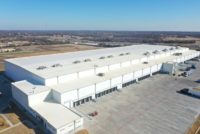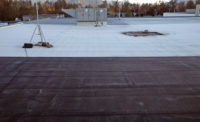
Photo courtesy of Atlas Roofing
In February, President Obama announced the Better Buildings Initiative, a multi-pronged effort to make commercial buildings 20 percent more energy efficient over the next decade by encouraging private sector investment through incentives to upgrade schools, universities and municipal facilities, as well as offices, stores and other commercial buildings.
One of the best and simplest ways to achieve a high degree of energy efficiency is by increasing the levels of insulation on the roof. In fact for long-term energy savings, the commercial roofing market provides a significant multiplier effect to accelerate energy efficiency efforts. For every new roof installed on a new building, approximately three additional roofs are installed on existing buildings to replace older, less energy-efficient systems. Therefore a significant opportunity to increase building energy efficiency lies within the commercial roofing sector, where over 50 billion square feet of flat roofs are currently available for retrofit, 4 billion of which are retrofit each year.
If the insulation levels in these commercial roofs were upgraded from their current R-value to the high performance levels embodied in a High R Roof - 50 percent above the minimum required values - annual energy savings would exceed $2 billion. (For more information,click here)
For rooftops to become vital contributors to the ambitious goal of national energy efficiency and independence, building owners in both the public and private sectors need to understand the specific factors to be considered when making investment decisions about roof insulation. In addition, building professionals need to understand the necessary construction and operating practices which will ensure the High R Roofs will deliver that anticipated energy savings throughout their entire service lives. Finally, these high performance roofing guidelines and operating practices must be targeted to address the unique conditions of re-roofing, where energy upgrades can contribute the greatest value.

The ASHRAE Standard 90.1 committee, approved a proposal to increase the minimum required prescriptive R-values for roof and wall insulation levels in the 2010 version of the standard. While still under final review, expect this code to change very soon.
The High R Roof
So what is a High R Roof and, more importantly, why would a building owner want one?A High R Roof is a roof that provides a level of thermal resistance, or R-value, higher than current minimum building code standards and practices. These roofs have many benefits: they save money, increase the energy efficiency of a building and reduce carbon emissions. On a larger scale, High R Roofs contribute to achieving goals of national energy efficiency and independence.
Energy Codes and Standards
Energy codes typically specify requirements for “thermal resistance” in the building shell and windows, minimum air leakage, and minimum efficiency for heating and cooling equipment. Stronger national model building energy codes and standards mean better energy efficiency in commercial buildings and are an integral part of a High R Roof.• ASHRAE 90.1-2007. ASHRAE 90.1, set by the American Society of Heating, Refrigerating and Air-Conditioning Engineers (ASHRAE), represents the minimum standard for roof insulation levels. In 2007, the R-value requirements for this standard were increased by 33 percent for climate zones 2 thru 8. The above-deck roof insulation requirements for those climate zones increased from R-15 to R-20. Note that at the end of 2010, the ASHRAE Standard 90.1 committee approved a proposal to increase the minimum required prescriptive R-values for roof and wall insulation levels in the 2010 version of the standard. While still under final review, expect this code to change very soon.
• IECC. Introduced by the International Code Council (ICC), the International Energy Conservation Code (IECC), which is being adopted rapidly by state and local code jurisdictions across the United States, incorporates the ASHRAE 90.1 standard. The code contains minimum energy efficiency provisions for residential and commercial buildings and also features building envelope requirements for thermal performance and air leakage. Note that the 2012 IECC calls for a 30 percent increase in energy savings in residential and commercial buildings as compared to the 2006 code. This represents the single largest efficiency increase in the history of the model energy code. (See Figure 1.)
How to Ensure Energy Efficiency and Longevity
According to numerous studies, the energy savings provided by well-insulated roofing may be compromised by a few conditions, including thermal breaks in the system, moisture infiltration and roof traffic. The following tips can help you deal with these issues, allowing you to get the best bang for your buck when it comes to High R Roofs.Thermal breaks can occur at joints or gaps in the insulation layers and at intersections with building walls, impacting the energy efficiency of a home or building. Important practices to minimize this energy-loss include:
• Careful measurement, cutting and fitting of insulation materials. By cutting insulation materials in the field to the proper measure and fit of a particular roof, significant thermal value can be retained.
• Installing insulation boards in two or more staggered layers. Multi-layering of roof insulation boards can reduce the potential for thermal loss at board joints.
Moisture infiltration into a roof system, either from leaks in the roofing membrane or through vapor drive within the building, can seriously degrade insulation performance and reduce the overall service life of the entire roofing system. Important practices to minimize the effects of moisture infiltration include:
• Effective moisture barrier design. Buildings in regions with cold winter climates or with high internal levels of moisture or humidity should consider the use of a vapor retarder if testing suggests that moisture could condense within the roofing system.
• Protection of jobsite materials prior to installation. Packages of insulation or roofing materials should be elevated above the ground or roof with blocking and covered with protective tarps to reduce the potential for moisture intrusion.
• Durable roofing membrane selection. Regions with high winds or heavy hailstorms should use roofing membranes that meet or exceed anticipated weather and operating conditions for the roof.
• Ongoing roof inspection and maintenance. Roofing systems should be inspected periodically in order to ensure that minor roof damage or weather does not lead to major events, such as water intrusion. Like moisture infiltration, excessive foot traffic or equipment movement on a rooftop can compromise insulation performance and reduce the overall service life of the roof.
Important practices to minimize roof traffic damage include:
• Walkway systems to protect the roof surface and direct traffic flow. Walkway systems minimize roof traffic damage, can further protect the roof surface and underlying insulation from damage and help limit foot traffic in non-protected areas.
• Use of cover boards. High compressive strength cover boards can protect the underlying insulation by spreading the point loads of roof traffic across a wider surface area.

A worker installs tapered polyiso insulation during a re-roofing project. Photo courtesy of Firestone Building Products.
Making the Decision to Replace Your Roof
Understanding the condition of an existing roof and building are critical for successful High R Roof installation, even if the existing roofing system is removed in its entirety. Prior to the installation of a High R Roof, inspect the roof and test the roof for moisture levels.Similarly, because the insulation levels recommended for High R Roofs require greater total roof system thickness compared to older roofing systems, wall and curb flashings may need to be modified to ensure effective drainage.
The Role of Polyiso in High R Roofs
Polyiso is a rigid foam insulation used in over 70 percent of commercial roof construction, in commercial sidewall construction and in residential construction. Polyiso has zero ozone depletion potential and virtually no global warming potential.High R Roofs are constructed using polyiso insulation due to its many benefits. In addition to having the highest R-value per inch of thickness, polyiso is moisture resistant, has superior compressive strength and dimensional stability, and has shown excellent performance in fire tests. Moreover, using polyiso in the construction of a High R Roof can result in a thinner roof with shorter fasteners.
Its nationwide availability, preferred insurance ratings, extensive building code approvals and compatibility with most roofing systems make polyiso insulation a logical, cost-effective choice when it comes to roofing systems.
President Obama's Better Buildings Initiative
At the start of 2011, President Obama announced a multi-pronged effort to make commercial buildings 20 percent more energy efficient over the next decade. The Better Buildings Initiative outlines several goals, including offsetting the cost of electricity by roughly $40 billion per year for business and landlords and saving energy by reforming outdated incentives and challenging the private sector to act.The steps to achieve these goals include:
• Providing new, workable tax incentives to encourage building efficiency.
• Offering more financing opportunities for commercial retrofits.
• Proposing new competitive grants to states and/or local governments that streamline standards, encourage upgrades and attract private sector investment.
• A pilot program allowing the Department of Energy to guarantee private loans for energy efficiency upgrades at hospitals, schools and other buildings.
• Challenging CEOs and University presidents to move toward energy efficiency.
• Training the next generation of commercial building technology workers.





